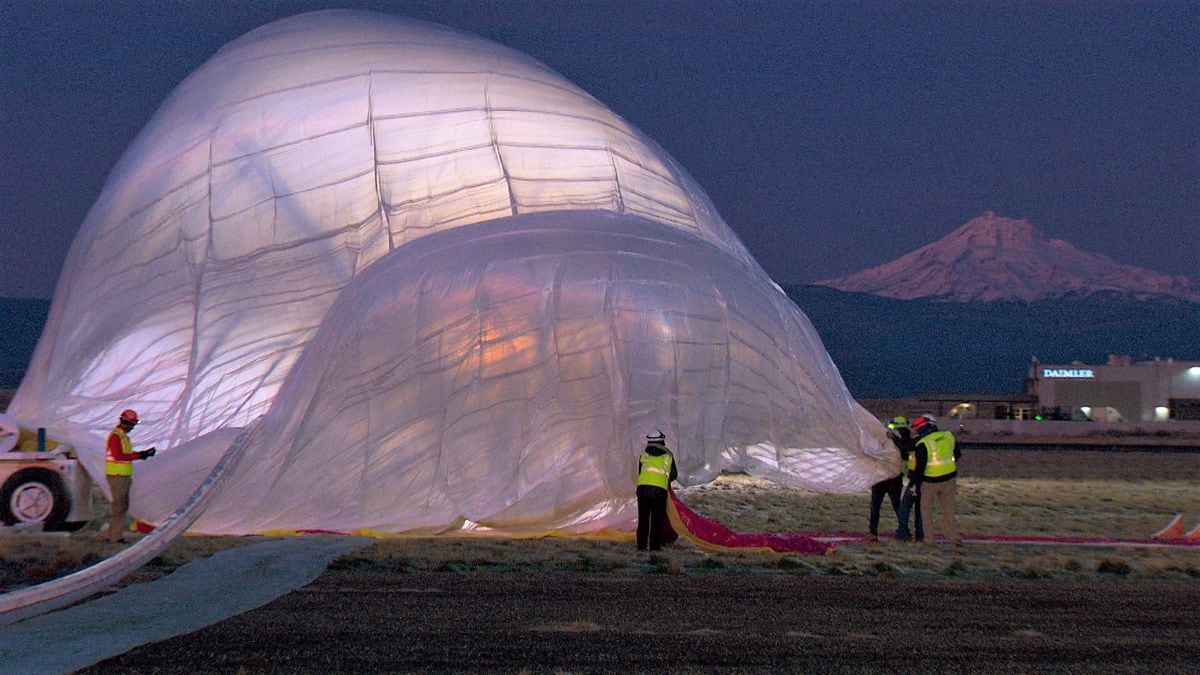The Near Space Corporation crew manages the upper portion of the high-altitude balloon at the Madras Airport.
A crew led by Vic Rogers from Near Space Corporation has been working all night preparing for inflation.
Off to one side, Near Space President Kevin Tucker braces himself with a large air hose on the tarmac.
This massive balloon will carry precious cargo from the European Space Agency, ESA, into the stratosphere to test the parachute of a new Mars rover.
After working through the night, Near Space Corporation President Kevin Tucker (right) holds onto a diffuser at the junction of the air hose and inflation tube.
Tillamook-based Near Space Corporation has made its name with high-altitude balloons — testing equipment for space agencies around the world on the coast and in Central Oregon?
Central Oregon is a near-perfect place for this kind of parachute testing because of its remoteness and relatively consistent weather, all good things when you’re trying to send a giant balloon and a test module more than 100 thousand feet up.
Months ahead of launch, each balloon is hand assembled and tested at Near Space Corporation's headquarters in Tillamook.
Before the high-altitude balloons ever make their debut over the high desert, they’re constructed and tested at Near Space Corporations’ headquarters in Tillamook.
The massive balloon rises, billowing audibly with surprising volume.
The sheer-white balloon picks up speed as it rises into the winter-blue sky.
The balloon shrinks into the distance as the winds carry it southeast across the high desert.
The partially inflated high-altitude balloon drifts skyward over a crane truck on the runway.
Near Space Corporation.
His job is to track down and recover the parachute and module in the desert and then eventually the deflated balloon.
The team is holding on the side of a rural road, waiting for the balloon to reach the target height.
The balloon finally comes into view, a white speck in the far distance.
The European Space Agency's module drifts over Central Oregon, buoyed by a high-altitude balloon.
Near Space Corporation.
The ESA module comes down five miles from the closest road, so the recovery crew loads into four ATVs and hits the rough open trail across the desert.
A stand of juniper covers a hill in the distance, raising fears of a difficult extraction from both the Near Space and European crewmembers.
Recovery leader Jake Young directs his team to the touchdown location of the ESA parachute.
“What we’re hoping to find is a nice pristine parachute, and the test vehicle that’s intact and some good data,” says Joe Lynch, an engineer with ESA contractor Vorticity Systems.
The European team wastes no time documenting the condition of the parachute, which is tangled in the groundcover.
There are no obvious signs of damage on the parachute, but they won’t know for sure until they get back to Europe where every inch of the massive parachute will be examined
The results will have broad implications for ESA’s ExoMars mission, which was initially scheduled to launch in September 2022 in partnership with Roscosmos, the Russian space agency
On the ground, the recovery team carefully untangles and rolls up the parachute
The high-altitude test will soon be approaching the 24-hour mark, and there’s still more clean-up work ahead
The recovery crew for Near Space Corporation travel into the Central Oregon backcountry to the landing spot of the parachute
